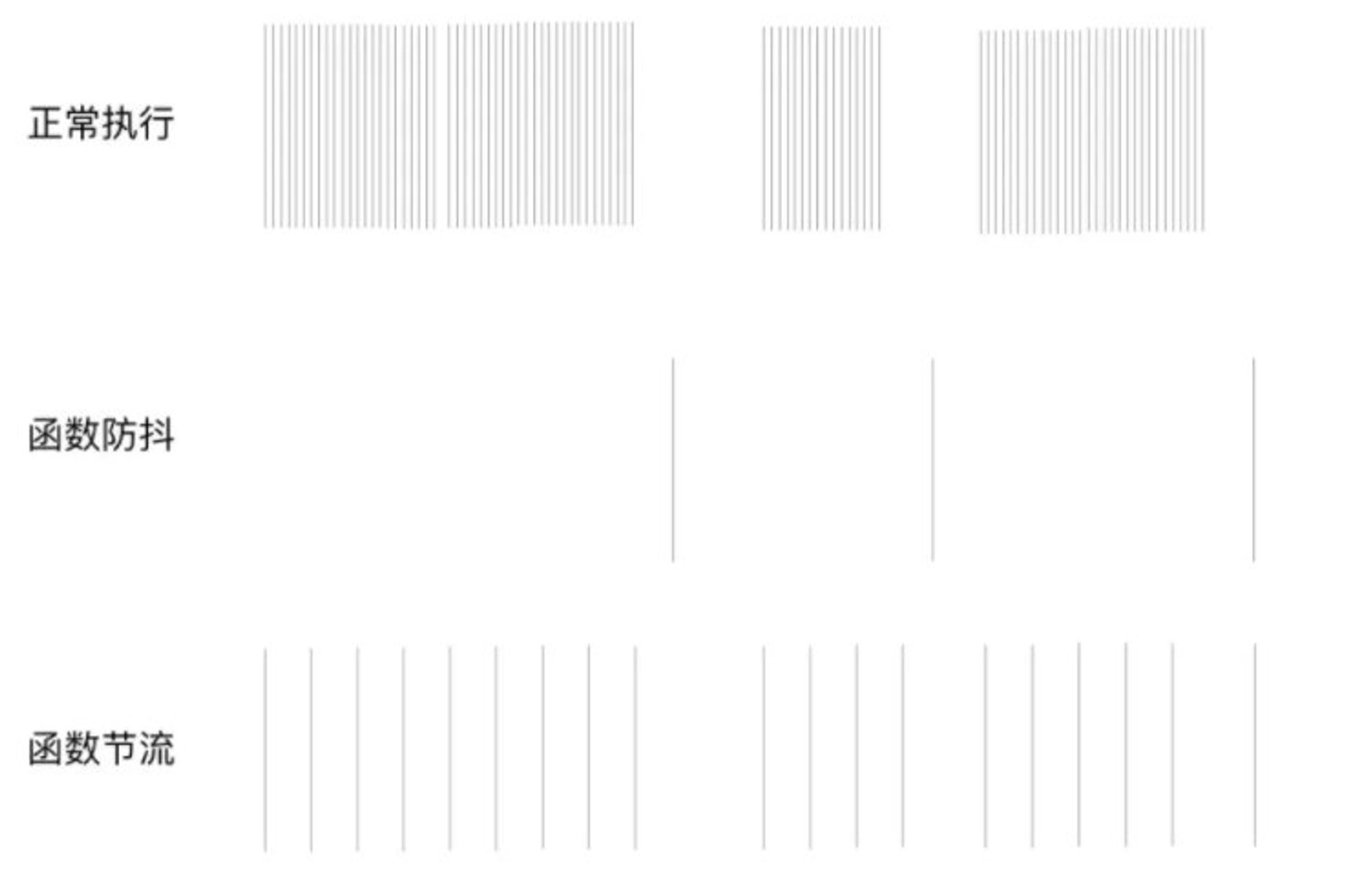type
Post
status
Published
date
Jun 3, 2022
slug
throttle-and-debounce
summary
防抖和节流是前端事件驱动编程中常用的概念,也是面试中经常问起的八股。当然,面试中手写基本的防抖和节流也是常考的。
tags
前端
开发
category
学习思考
icon
password
Property
Nov 13, 2022 08:13 AM
在浏览器中,JavaScript 事件循环在时刻不停运行着,随时准备处理任务队列里面的事件处理程序。一些例如
input输入事件、scroll滚动事件的事件处理程序有可能因为事件的触发频繁而被高频调用。众所周知,JavaScript 主线程只有一个,当前执行栈如果一直有代码执行,那么就会导致用户交互失去响应。为了减少高频事件处理程序频繁调用,需要采用两种策略:防抖(debounce)和节流(throttle)。它们本质上都是优化高频率执行代码的一种手段。认识防抖和节流
除了之前提到的事件外,例如浏览器的
resize、keypress、mousemove等事件在触发时,会不断地调用绑定在事件上的回调函数,极大地浪费资源,降低前端性能。优化此类事件处理程序的执行频率是必要的,为此引入函数防抖和节流:
- 防抖:在给定时间
t之后执行函数,如果函数执行在t范围内被重复触发,则重新计时。
- 节流:在给定时间
t内只执行一次函数,如果函数执行t范围内被重复触发,则只有一次生效。
一个非常经典的比喻,想象每天上下班写字楼的电梯。把电梯每完成一次运送看作是一次事件的响应和回调函数的执行。假设电梯具有两种策略,
debounce和throttle,设定时间为 15 秒,不考虑容量限制:1)一个人进来后,15 秒后电梯准时运送一次,这是节流;2)一个人进来后,电梯等待 15 秒,如果 15 秒内有其他人进来,那么 15 秒倒计时重新计算,这是防抖。推荐:一个非常形象的演示

实现函数防抖
简单版本实现
因为函数防抖是在事件停止触发一段时间之后延迟调用处理程序,因此可以使用定时器实现。
一个简单版本使用定时器的实现如下:
function debounce(func, wait) { let timeout = null return function () { let context = this let args = arguments clearTimeout(timeout) timeout = setTimeout(() => { func.apply(context, args) }, wait) } }
如果需要防抖函数立即执行,可以加入第三个参数用来判断:
function debounce(func, wait, immediate) { let timeout = null return function () { let context = this let args = arguments clearTimeout(timeout) if (immediate) { // 第一次会立即执行,以后需要等待事件停止触发一段时间后才会执行 let callNow = !timeout timeout = setTimeout(() => { timeout = null }, wait) if (callNow) { func.apply(context, args) } } else { timeout = setTimeout(() => { func.apply(context, args) }) } } }
lodash源码实现
import isObject from './isObject.js' import root from './.internal/root.js' function debounce(func, wait, options) { let lastArgs, lastThis, maxWait, result, timerId, lastCallTime let lastInvokeTime = 0 let leading = false let maxing = false let trailing = true // Bypass `requestAnimationFrame` by explicitly setting `wait=0`. const useRAF = !wait && wait !== 0 && typeof root.requestAnimationFrame === 'function' if (typeof func !== 'function') { throw new TypeError('Expected a function') } wait = +wait || 0 if (isObject(options)) { leading = !!options.leading maxing = 'maxWait' in options maxWait = maxing ? Math.max(+options.maxWait || 0, wait) : maxWait trailing = 'trailing' in options ? !!options.trailing : trailing } function invokeFunc(time) { const args = lastArgs const thisArg = lastThis lastArgs = lastThis = undefined lastInvokeTime = time result = func.apply(thisArg, args) return result } function startTimer(pendingFunc, wait) { if (useRAF) { root.cancelAnimationFrame(timerId) return root.requestAnimationFrame(pendingFunc) } return setTimeout(pendingFunc, wait) } function cancelTimer(id) { if (useRAF) { return root.cancelAnimationFrame(id) } clearTimeout(id) } function leadingEdge(time) { // Reset any `maxWait` timer. lastInvokeTime = time // Start the timer for the trailing edge. timerId = startTimer(timerExpired, wait) // Invoke the leading edge. return leading ? invokeFunc(time) : result } function remainingWait(time) { const timeSinceLastCall = time - lastCallTime const timeSinceLastInvoke = time - lastInvokeTime const timeWaiting = wait - timeSinceLastCall return maxing ? Math.min(timeWaiting, maxWait - timeSinceLastInvoke) : timeWaiting } function shouldInvoke(time) { const timeSinceLastCall = time - lastCallTime const timeSinceLastInvoke = time - lastInvokeTime // Either this is the first call, activity has stopped and we're at the // trailing edge, the system time has gone backwards and we're treating // it as the trailing edge, or we've hit the `maxWait` limit. return ( lastCallTime === undefined || timeSinceLastCall >= wait || timeSinceLastCall < 0 || (maxing && timeSinceLastInvoke >= maxWait) ) } function timerExpired() { const time = Date.now() if (shouldInvoke(time)) { return trailingEdge(time) } // Restart the timer. timerId = startTimer(timerExpired, remainingWait(time)) } function trailingEdge(time) { timerId = undefined // Only invoke if we have `lastArgs` which means `func` has been // debounced at least once. if (trailing && lastArgs) { return invokeFunc(time) } lastArgs = lastThis = undefined return result } function cancel() { if (timerId !== undefined) { cancelTimer(timerId) } lastInvokeTime = 0 lastArgs = lastCallTime = lastThis = timerId = undefined } function flush() { return timerId === undefined ? result : trailingEdge(Date.now()) } function pending() { return timerId !== undefined } function debounced(...args) { const time = Date.now() const isInvoking = shouldInvoke(time) lastArgs = args lastThis = this lastCallTime = time if (isInvoking) { if (timerId === undefined) { return leadingEdge(lastCallTime) } if (maxing) { // Handle invocations in a tight loop. timerId = startTimer(timerExpired, wait) return invokeFunc(lastCallTime) } } if (timerId === undefined) { timerId = startTimer(timerExpired, wait) } return result } debounced.cancel = cancel debounced.flush = flush debounced.pending = pending return debounced } export default debounce
实现函数节流
简单版本实现
节流可以使用时间戳或者定时器来实现。
使用时间戳实现的简单版本如下:
function throttle(func, delay) { let oldTime = Date.now() return function () { const context = this const args = arguments let newTime = Date.now() if (newTime - oldTime >= delay) { func.apply(context, args) oldTime = Date.now() } } }
使用定时器写法的简单版本如下:
function throttle(func, delay) { let timer = null return function () { const context = this const args = arguments if (!timer) { timer = setTimeout(() => { func.apply(context, args) timer = null }, delay) } } }
可以将时间戳和定时器相结合,实现一个较为精确的节流:
function throttle(func, delay) { let timer = null let oldTime = Date.now() return function () { let newTime = Date.now() // 计算从上一次倒现在,还剩多少时间 let remaining = delay - (newTime - oldTime) const context = this const args = arguments clearTimeout(timer) if (remaining <= 0) { func.apply(context, args) oldTime = Date.now() } else { timer = setTimeout(() => { func.apply(context, args) }, remaining) } } }
lodash源码实现
import debounce from './debounce.js' import isObject from './isObject.js' function throttle(func, wait, options) { let leading = true let trailing = true if (typeof func !== 'function') { throw new TypeError('Expected a function') } if (isObject(options)) { leading = 'leading' in options ? !!options.leading : leading trailing = 'trailing' in options ? !!options.trailing : trailing } return debounce(func, wait, { leading, trailing, maxWait: wait, }) } export default throttle
- Author:Louis K
- URL:https://louisk.xyz/article/throttle-and-debounce
- Copyright:All articles in this blog, except for special statements, adopt BY-NC-SA agreement. Please indicate the source!
Relate Posts
